According to the Occupational Safety and Health Administration (OSHA), a US federal agency, around 1.8 million workers are affected by Repetitive Stress Injury (RSI) every year. The injuries cost about $20 billion to the US economy in a year.
RSI is a musculoskeletal and nervous system injury caused typically due to repetitive tasks. Any job that requires sitting behind a desk for extended periods of time may cause this medical condition. Professionals who work on computers for hours together experience wrist, back and neck pain. Sounds familiar?
These musculoskeletal disorders lead to hundreds of lost workdays, spelling trouble for businesses. Something as trivial as wrong type of desks can prove fatal in the long run. So, how can companies avoid this situation, protect their employees from work-related injuries and in turn increase the productivity of the businesses? That’s where a stellar office design comes in!
Does Ergonomics Really Matter?
Our answer is – Yes! Ergonomics is the science of designing offices that meet the work demands and suit the capabilities of employees. As workers spend the chunk of their time at workplaces, it is essential that the present-day offices are designed keeping the ergonomics in mind. Beside being aesthetically-pleasing, workspaces should feel inviting rather than intimidating to the visitors as well as employees.
Uncomfortable postures can induce work-related stress, causing injuries and illnesses. Cluttered workplaces negatively impact the health of employees and bring down their morale. Making a few worker-friendly changes in offices can promote health and boost productivity.
Before getting started with creating ergonomically-compliant workplaces, it is important to evaluate the following aspects:
- The physical, mental and emotional needs of employees
- The physical, mental and emotional abilities of employees
- The rift between the needs and abilities
Once the evaluation is made, one should ask a few important questions such as:
- What kind of a workplace is it?
- How is the lighting used?
- What are the noise levels?
- How much time is taken to complete a certain task?
- What tools are used to perform tasks?
Smart office designers collect all the essential information before developing the office design strategies. The best workplaces are designed to fit the human needs and do not force the humans to fit into the design. It is a great idea to involve employees in the design process that will make them take the ownership of their workstations. This will bring about a positive change in their attitudes and establish a conducive atmosphere that will yield successful results.




Recent Comments